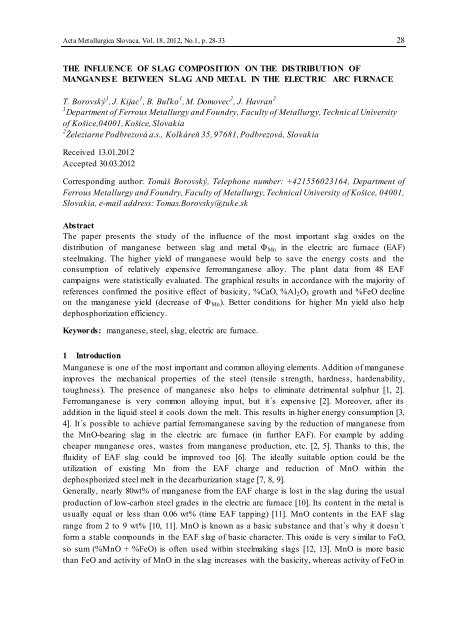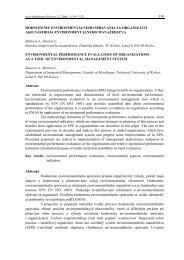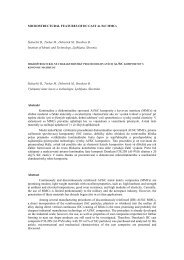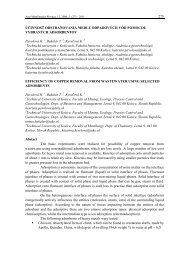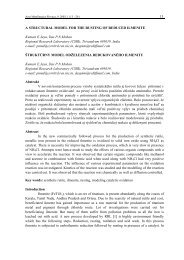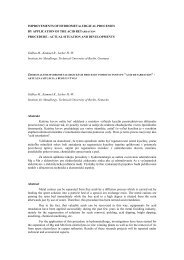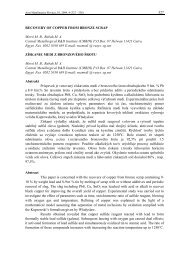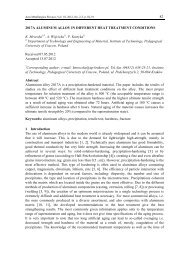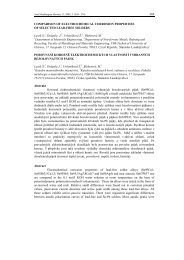28 THE INFLUENCE OF SLAG COMPOSITION ON THE ...
28 THE INFLUENCE OF SLAG COMPOSITION ON THE ...
28 THE INFLUENCE OF SLAG COMPOSITION ON THE ...
- No tags were found...
Create successful ePaper yourself
Turn your PDF publications into a flip-book with our unique Google optimized e-Paper software.
Acta Metallurgica Slovaca, Vol. 18, 2012, No.1, p. <strong>28</strong>-33 <strong>28</strong><strong>THE</strong> <strong>INFLUENCE</strong> <strong>OF</strong> <strong>SLAG</strong> <strong>COMPOSITI<strong>ON</strong></strong> <strong>ON</strong> <strong>THE</strong> DISTRIBUTI<strong>ON</strong> <strong>OF</strong>MANGANES E BETWEEN <strong>SLAG</strong> AND METAL IN <strong>THE</strong> ELECTRIC ARC FURNACET. Borovský 1 , J. Kijac 1 , B. Buľko 1 , M. Domovec 2 , J. Havran 21 Department of Ferrous Metallurgy and Foundry, Faculty of Metallurgy, Technical Universityof Košice,04001, Košice, Slovakia2 Železiarne Podbrezová a.s., Kolkáreň 35, 97681, Podbrezová, SlovakiaReceived 13.01.2012Accepted 30.03.2012Corresponding author: Tomáš Borovský, Telephone number: +421556023164, Department ofFerrous Metallurgy and Foundry, Faculty of Metallurgy, Technical University of Košice, 04001,Slovakia, e-mail address: Tomas.Borovsky@tuke.skAbstractThe paper presents the study of the influence of the most important slag oxides on thedistribution of manganese between slag and metal Φ Mn in the electric arc furnace (EAF)steelmaking. The higher yield of manganese would help to save the energy costs and theconsumption of relatively expensive ferromanganese alloy. The plant data from 48 EAFcampaigns were statistically evaluated. The graphical results in accordance with the majority ofreferences confirmed the positive effect of basicity, %CaO, %Al 2 O 3 growth and %FeO declineon the manganese yield (decrease of Φ Mn ). Better conditions for higher Mn yield also helpdephosphorization efficiency.Keywords: manganese, steel, slag, electric arc furnace.1 IntroductionManganese is one of the most important and common alloying elements. Addition of manganeseimproves the mechanical properties of the steel (tensile s trength, hardness, hardenability,toughness). The presence of manganese also helps to eliminate detrimental sulphur [1, 2].Ferromanganese is very common alloying input, but it´s expensive [2]. Moreover, after itsaddition in the liquid steel it cools down the melt. This results in higher energy consumption [3,4]. It´s possible to achieve partial ferromanganese saving by the reduction of manganese fromthe MnO-bearing slag in the electric arc furnace (in further EAF). For example by addingcheaper manganese ores, wastes from manganese production, etc. [2, 5]. Thanks to this, thefluidity of EAF slag could be improved too [6]. The ideally suitable option could be theutilization of existing Mn from the EAF charge and reduction of MnO within thedephosphorized steel melt in the decarburization stage [7, 8, 9].Generally, nearly 80wt% of manganese from the EAF charge is lost in the slag during the usualproduction of low-carbon steel grades in the electric arc furnace [10]. Its content in the metal isusually equal or less than 0.06 wt% (time EAF tapping) [11]. MnO contents in the EAF slagrange from 2 to 9 wt% [10, 11]. MnO is known as a basic substance and that´s why it doesn´tform a stable compounds in the EAF slag of basic character. This oxide is very s imilar to FeO,so sum (%MnO + %FeO) is often used within steelmaking slags [12, 13]. MnO is more basicthan FeO and activity of MnO in the slag increases with the basicity, whereas activity of FeO in
Acta Metallurgica Slovaca, Vol. 18, 2012, No.1, p. <strong>28</strong>-33 29the slag behaves in opposite manner [2, 3]. The manganese oxide is unstable. It greatly dependson the temperature i.e. the increase in temperature results in the decomposition of MnO [10, 14,15]. Except of temperature, the distribution of Mn between slag and metal expressed as Φ Mn =(%MnO)/[%Mn] is also a function of other parameters. Φ Mn decreases with the basicity or%CaO growth [7, 10, 15, 16, 17]. However according to [4, 18], the inverse effect of basicitywas observed. Alumina has no negative effect on Mn yield [17]. Silica reacts with MnO and thuslowers Mn yield [2]. Rising iron oxide contents are increasing Φ Mn values [2, 4, 7, 8, 16, 19, 20].The diffusion of Mn from metal to slag-metal interface is the rate-limiting step in the kinetics ofmanganese oxidation [15]. Oxidizing effect of FeO is even accelerated with basicity growth [8].According to [17], the graphical relationship Φ Mn = f(%FeO) shows a presence of maximum, i.e.after exceeding a certain value of %FeO the values of Φ Mn will be slightly decreased. Forexample, EAF slag containing 3 - 20 wt% MnO, with B 2 = (%CaO)/(%SiO 2 ) ~ 2, has itsmaximum Φ Mn value at ~ 35 wt % FeO [17]. The reduction rate of manganese oxide isintensified with increasing of MnO activity in the EAF slag and rise of temperature [21].2 Materials and methodicThe influence of major EAF slag compounds on the manganese distribution between slag andmetal Φ Mn was graphically investigated based on the EAF plant data. The average values from48 EAF campaigns were treated. Minimal and maximal average values of this statistical set areshowed in Table 1. Φ Mn or Φ P values were calculated as a (%MnO)/[%Mn] ratio or(%P 2 O 5 )/[%P] ratio, respectively.Table 1 Minimal and maximal values of selected EAF slag and metal constituents, 48 EAFcampaigns.(%CaO ) (%MgO ) (%Al 2O 3) (%SiO 2) (%FeO ) (%MnO ) (%P 2O 5) [%C ] [%Mn][%P]min.wt%maxwt%16,655 1,857 2,913 9,170 27,526 4,780 0,435 0,057 0,039 0,00634,403 6,601 6,352 14,961 51,250 5,951 0,882 0,082 0,083 0,012The basicity B 2 was calculated as a binary basicity B 2 = (%CaO)/(%SiO 2 ). %FeO represents thesum of %FeO and %Fe 2 O 3 . The slag and metal samples were manually taken by EAF operatorfrom the slag door area approximately at ~ 1550 – 1560°C, 7-12 minutes before EAF tapping.The metal samples were analyzed by spectrometry. The slag samples were then analyzed by X-ray spectrometer.3 Results and discussionAt first, the graphical relationships of Φ Mn versus %CaO (Fig.1), binary basicity B 2 (Fig.2) wereconstructed. It was shown that Φ Mn values are decreasing owing to rise of %CaO content of theEAF slag. Also rise of binary basicity caused decline of Φ Mn values. So, these graphsdemonstrated that Mn yield is higher with increasing of basic compounds (especially CaO) ofEAF slag. This result is in agreement with the majority of references [7, 10, 15, 16, 17]. Therewasn´t registered any negative influence of basicity like it was presented in [4, 18]. Highbasicity is also needed for effective dephosphorization. It´s well known that higher magnesiacontents in the EAF slag are favorable for EAF hearth refractory lining.
Acta Metallurgica Slovaca, Vol. 18, 2012, No.1, p. <strong>28</strong>-33 30Fig.1 Manganese distribution ΦMn as function of calcium oxide content in the EAF slagFig.2 Manganese distribution ΦMn as function of binary basicity B 2 of EAF slagFig.3 Manganese distribution ΦMn as function of alumina content in the EAF slag
Acta Metallurgica Slovaca, Vol. 18, 2012, No.1, p. <strong>28</strong>-33 31Fig.4 Manganese distribution ΦMn as function of iron oxides content in the EAF slagFig.5 Manganese distribution ΦMn vs. phosphorus distribution ΦpThere was found a relationship between Φ Mn and alumina content in EAF slag. It could be seenfrom the Fig.3 that rise of %Al 2 O 3 content favors Mn yield. This phenomenon can be elucidatedby the fact that alumina is a commonly used fluidizer of EAF slags.The graphical relationship of Φ Mn versus %FeO demonstrated strong oxidizing effect of risingiron oxide content in the EAF slag (see Fig.4). This means that increasing of iron oxides contentin the EAF slag lowers Mn yield (i.e. rising Φ Mn values). This fact corresponds with the resultsof other authors [2, 4, 7, 8, 16, 19]. There wasn´t spotted any maximum point in the curve like itwas mentioned in [17].Finally, the relationship between manganese distribution Φ Mn and phosphorus distribution Φ Pwas investigated (see Fig.5). The Φ P represents quantitative parameter of dephosphorization, i.e.Φ P = (%P 2 O 5 )/[%P]. Since phosphorus is very detrimental element for steel mechanicalproperties, Φ P values should be reached as high as possible. The curve from the Fig.5 shows thatthe highest Φ P values are achieved when Φ Mn values are as low as possible. Thus, both higherMn yield and better phosphorus removal could be achieved by certain conditions (high B 2basicities, optimal %FeO content, low slag viscosity).
Acta Metallurgica Slovaca, Vol. 18, 2012, No.1, p. <strong>28</strong>-33 324 ConclusionsThis article deals with the influence of important EAF slag compounds on the manganesedistribution between slag and metal Φ Mn and eventually the relationship between Φ Mn and Φ P isstudied. The plant data from 48 EAF campaigns were statistically evaluated. The graphicalrelationships in agreement with the majority of references proved that higher Mn yield requireshigh calcium oxide content, high B 2 basicity levels and lower %FeO content. No negative effectof basicity or no maximum within the Φ Mn = f(%FeO) function were observed. It was shown thathigher %Al 2 O 3 is helpful for Mn yield. Last graph proved close relationship between manganeseand phosphorus oxidation. From the aforementioned results, it can be concluded that botheffective dephosphorization and high Mn yield require management of EAF technology in theway of higher B 2 ratios (B 2 ≥ 2,4) and optimizing of %FeO content in the EAF slag (%FeOshouldn´t exceed 35 wt%). Some negative factors, that could scatter the results, must bementioned: manual sampling, sample contamination, oxygen jet used before sampling, vicinityof oxy-fuel burner, problems with scrap quality, etc.AcknowledgementsThis work was realized within the grant project No. 1/0783/11 “The research of interactions inthe slag-metal system in steelmaking processes“ with the financial support of VEGA MŠ SR andSAV.References[1] F. Kistifory, M. Mohyla, D. Mikuláš, J. Vítek: Acta Metallurgica Slovaca, Vol.10, 2004,No.3, p.236-241.[2] S.-M. Jung, Ch.-H. Lee, D.-J. Min: ISIJ International, Vol.42, 2002, No.1, p. 63-70.[3] A.T. Morales, R.J. Fruehan: Metallurgical And Materials Transactions B, Vol. <strong>28</strong>, 1996,No. 6, p. 1111-1118.[4] O. A. El Hady, A. E. Amer, I. S. El Mahallawi, Y. S. Shash: Materials Science Forum,Vol. 561 - 565, 2007, p. 85-89.[5] G. Li, T. Hamano, F. Tsukihashi: ISIJ International, Vol.45, 2005, No.1, p. 12-18.[6] G. J. W. Kor: Metallurgical Transactions B, Vol. 8B, 1977, No.1, p. 107-113.[7] S.-M. Jung: ISIJ International, Vol.43, 2003, No.2, p. 216-223.[8] H. Suito, R. Inoue: ISIJ International, Vol. 35, 1995, No.3, p. 266-271.[9] H. Suito, R. Inoue: ISIJ International, Vol. 35, 1995, No.3, p. 258-265.[10] P. Čižmárik: Electrometallurgy, Alfa, Bratislava, 1981, (in Slovak).[11] A. T. J. Jones: Electric arc furnace steelmaking, Nupro Corporation, American Iron andSteel Institute, [24.9.2010],http://www.steel.org/AM/Template.cfm?Section=Articles3&C<strong>ON</strong>TENTID=12308&TEMPLATE=/CM/HTMLDisplay.cfm[12] B. E. Pretorius, R.C. Carlisle: Iron & Steelmaker, Vol. 26, 1999, No.10, p. 79-88.[13] J. P. Bennet, K.-S. Kwong, R. Krabbe, J. P. Singh, E. C. Skaar, D. Wiskochil, C. L. Karr, E.Wilson: An overview of DOE´s program to recycle/reuse spent EAF refractories as a slagconditioner nad to extend refractory service life in the EAF, In.: AISE Steel technologyConference, Chicago, 2000, p. 41.[14] P. Fremunt, J. Šimon: Melting of steel in electric furnaces, SNTL, Praha, 1984 (in Czech).[15] M. Meraikib: ISIJ International, Vol.33, 1993, No.3, p. 352-360.
Acta Metallurgica Slovaca, Vol. 18, 2012, No.1, p. <strong>28</strong>-33 33[16] A. Sobandi, H. G. Katayama, T. Momono: ISIJ International, Vol.38, 1998, No. 9,p. 953-958.[17] Ch.-y. Zhu, G.-q. Li, Z.-p. Chen, G.-j. Ma, J. Liu: ISIJ International, Vol. 48, 2008, No. 2,p. 123-129.[18] K. N. Pata, S. Nakamura, K. Morita, N. Sano: ISIJ International, Vol. 36, 1996, No. 10,p. 1310-1312.[19] H. Suito, R.Inoue: Transactions ISIJ, Vol. 24, 1984, p. 257-265.[20] B. Buľko, J. Kijac, T. Borovský: Archives of Metallurgy and Materials, Vol. 56, 2011,No. 3, p. 605-609.[21] H. Sun, M.Y. Lone, S. Ganguly, O. Ostrovski: ISIJ International, Vol. 50, 2010, No. 5,p. 639-646.


